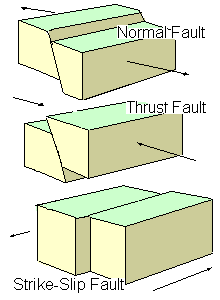Earthquakes
The shaking of the earth caused by a sudden shifting of rocks below its surface, is called an earthquake. The earths crust or outermost layer, is not made of one single piece of solid rock. It is actually made up of independent sheets of rocks called tectonic plates. These plates slide against each other, giving rise to physical changes in the earths topography. The places where these tectonic plates meet each other, are called fault lines.
Three famous areas that earthquakes occur are Chile, Japan and Alaska. All three of these areas are on or near a fault line.
Peru-Chile Trench
Chile is on the Peru-Chile Trench.The Peru-Chile Trench, also known as the Atacama Trench, is an oceanic trench in the eastern Pacific Ocean, about 160 kilometres (100 mi) off the coast of Peru and Chile. It reaches a maximum depth of 8,065 metres (26,460 ft) below sea level in Richards Deep and is approximately 5,900 kilometres (3,666 mi) long; its mean width is 64 kilometres (40 mi) and it covers an expanse of some 590,000 square kilometres (228,000 m²).
Mariana Trench
Japan sits on the Mariana Trench. The Mariana Trench is the deepest part of the world's oceans, and the lowest elevation of the surface of the Earth's crust. It is located in the western Pacific Ocean, to the east of the Mariana Islands. The trench is about 2,550 kilometres (1,580 mi) long but has a mean width of only 69 kilometres (43 mi). It reaches a maximum-known depth of about 11.03 kilometres (6.85 mi) at the Vityaz-1 Deep and about 10.91 kilometres (6.78 mi) at the Challenger Deep, a small slot-shaped valley in its floor, at its southern end. If Mount Everest, the highest mountain on Earth at 8,848 metres (29,029 ft), were set in the deepest part of the Mariana Trench, there would be 2,076 metres (6,811 ft) of water left above it.
The Denali Fault
Alaska sits on the Denali Fault Line. The Denali Fault is a major strike-slip fault in western North America, extending from northwestern British Columbia, Canada to the U.S. state of central Alaska The western 49 km of the rupture shows mainly low-angle thrust offset as much as 1.5 m, with the northwest side up.



